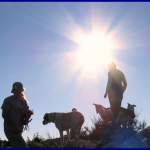Home › Forums › Science & History › New fossils of homo sapiens
-
AuteurMessages
-

MaraParticipant
chucksmith1982ParticipantI haven’t read all of the article, but it sounds interesting. All we need now are outside coraberation of the ub facts of humans starting in asia and horses in north America.

bowlingParticipantInteresting article that moves the date of Humans in the Americas. Urantia – 78:5.7 (873.3) One hundred and thirty-two of this race, embarking in a fleet of small boats from Japan, eventually reached South America and by intermarriage with the natives of the Andes established the ancestry of the later rulers of the Incas. They crossed the Pacific by easy stages, tarrying on the many islands they found along the way. The islands of the Polynesian group were both more numerous and larger then than now, and these Andite sailors, together with some who followed them, biologically modified the native groups in transit. Many flourishing centers of civilization grew up on these now submerged lands as a result of Andite penetration. Easter Island was long a religious and administrative center of one of these lost groups. But of the Andites who navigated the Pacific of long ago none but the one hundred and thirty-two ever reached the mainland of the Americas.
Black Hole May Have Solved Ancient Mystery Of The First Americans

Carl RParticipantThanks Mara for posting a link to that article. From what I can tell from the composite reconstruction in the article, the cranium looks human enough but the jaw and face look very neanderthal (no chin, heavy bone, very thick brows, etc.). I’m not a professional anthropologist, but from the evidence so far the distinction in this case is ambiguous to me.
It seems worth noting that describing this find as human makes it much more newsworthy than describing it as neanderthal. I have no idea if that played any part in the choice of classification, but it’s worth keeping in mind.
I can say that it’s worth keeping in mind that taxonomy can be a very political matter in the real world. You might think that the classifications of Asian wild sheep or your local songbirds might not have a lot of backroom dealing going on in relation to them, but that’s not the case at all. Both trophy hunters and birders tend to love « splitting » in taxonomy (the tendency to subdivide species as opposed to lumping them) since more species mean more chance to get your name in the record books. Both groups can apply more pressure than you might think in the small world of sheep and songbird taxonomy, and elsewhere. And if a proposed taxonomy may have implications with the Endangered Species Act, put on your tinfoil hat because conspiracy (real and imagined) will be everywhere! Skullduggery (sorry) can be all the more pervasive when it comes to anthropology and archaeology, where very little is without some kind of political implication (again, real or imagined).
All of which is to say that we should be careful regarding points of taxonomy in general, and the more revolutionary the finding is supposed to be the more cautious we should be. Also, the NYT article was a classic example of how most science reporting, even the better stuff, is 9/10 about the theoretical implications and 1/10 about the evidence per se.
That said I’m glad you posted the link. It will be interesting to see how this plays out. Thanks!

Mark606ParticipantAn interesting topic, Mara. I’m an archaeologist who has tried to correlate the commonly accepted scientific and archaeological evidence for human evolution with the story of evolution as given in the Urantia Book. I can only conclude that it is a real mess.
There are a number of reasons for all the conflicting evidence.
- The scientific assumption that human evolution has occurred in a linear progression. This is changing somewhat with new DNA evidence but discussions generally avoid how this affects fossil evidence. The UB points out that physical evolution can also be regressive, and that such events have occurred repeatedly by the interbreeding of specific populations. The book also points out that this is less likely to occur in later times because of differentiated gene pools (64.4.5).
- Conclusions are skewed by the overwhelming research in Africa, particularly along the East African Rift, as opposed to other regions. This region naturally exposes the Pliocene and Pleistocene epochs, making archeological finds a little easier. Such a geographical focus is bound to result in parochial views. Meanwhile, the UB claims that the some of the most relevant finds are buried in the Siwalik Hills, which extend from northern Pakistan, through northern India (64.3.4) (The UB does not mention Pakistan because it was written before the partition of India). As far as I know, the last paleontological excavation in this region was conducted by David Pilbeam in the 1970s, which resulted in the finds of Sivapithecus (or Ramapithecus). So much more is waiting to be found.
- Poor dating methods. The Moroccan finds were dated by means of thermoluminescence, which is notoriously inaccurate and requires a number of questionable assumptions. It is said to date objects up to 500,000 years but the range of error, even assuming perfect conditions, is 25%. The same applies to almost all forms of radiometric dating except radiocarbon dating. But radiocarbon dating, at best, cannot extend beyond 50,000 years.
Early dates for human evolution are almost entirely based on the radiometric dating of volcanic rocks (potassium-argon) which also assumes that the stratigraphic correlations of fossils and rock are accurate. This, I believe, explains why the dates established by modern science, not only in archaeology but also in geological research, are so widely separated from those in the UB.
Like Carl suggested, the fossil record is a real mess, not only because it assumes linear evolution but also because it is based on such scanty evidence, and is further influenced by academic status. Taxonomies work well when researching or determining major changes, but not so well when studying things like small changes in jaw and cranial sizes.
There is little agreement about who should be classed as Homo sapiens. The NYT article is based on an article appearing in Nature and the author assumes that H. sapiens developed from H. heidelbergensis somewhere between 800,000 to 300,000 ya. The UB describes Heidelberg as an Adonite (64.2.3) that preceded Neanderthal (900,000 ya), so the dates coincide to some degree. But some archaeologists claim Neanderthal is an early (archaic) H. sapiens. It can be quite confusing.
The book does not mention our commonly accepted taxonomies of H. neaderthalis or H. sapiens as such, even though the terms existed before 1934. On the basis of the book, there were nine races, the Andonites, six Sangiks, and the Adamites. But they also mention the proliferation of many backward peoples. The fossil record is a mish-mash of all of these.
Nonetheless, the Andonites roughly compare to H. erectus (although the latter is more primitive in form), the Neanderthal are archaic H. sapiens, the Sangiks are early modern H. sapiens, and the Adamite blends are “anatomically modern” H. sapiens.
The Sangiks still exist as many modern peoples attest, and they are clearly H. sapiens even if lacking Adamic blood. And because the Sangiks began around 500,000 ya (64.5), I see no reason to dispute the possibility that the Morrocco fossils are H. sapiens, but there is little evidence to assume the probability of such a claim.

MaraParticipantFrom what I can tell from the composite reconstruction in the article. . . .
Thanks Carl. . .I’m an archaeologist who has tried to correlate. . . .
. . . and to you Mark for your comments! Interesting stuff.
-
AuteurMessages
Login to reply to this topic.
Not registered? Sign up here.
